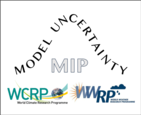Leverhulme Trust Research Project team meeting 1
Minutes
Friday 12 January, 2024
Present:
Hannah Christensen (University of Oxford)
Edward Groot (University of Oxford)
Hugo Lambert (University of Exeter)
Romain Roehrig (Météo-France)
Kasturi Singh (University of Exeter)
Keith Williams (UK Met Office)
Files:
KS plans
KS shared some plans about LES for constraining turbulence parametrisations (see slides) Those approaches could potentially contribute to enhancing the depiction of convective cells in SCMs.
HC indicated this would be of interest to MU-MIP, as a higher-fidelity datapoint to compare to the km-scale runs and parametrised SCM predictions.
EG expressed interest and indicated his own PhD work was on related topics.
There was a discussion about how best to select times/places for these runs, given their expense.
RR suggested a process/regime-based selection. RR also flagged up work at Météo-France on km-scale stochastic parametrisation, which may be of interest.
https://link.springer.com/article/10.1007/s10546-021-00682-6
RR also reminded all of related work from Tapio Schneider’s group for producing a wide set of LES (e.g. see papers: https://agupubs.onlinelibrary.wiley.com/doi/full/10.1002/2017GL076101
https://agupubs.onlinelibrary.wiley.com/doi/10.1029/2021MS002631)
Parameter perturbation
U. Exeter opened a discussion on how to select parameters to perturb and proposed some specific parameters for consideration as well . They further asked about whether there was already a predefined list of parameters for perturbation existed for the project.
HC highlighted the importance of first completing the control runs for MU-MIP. This was reiterated by KW and RR.
HC indicated that Oxford were not (necessarily) planning any parameter perturbation experiments, and neither (to her knowledge) were the DTC. Given the specifics of each model, it could be up to each group what to perturb. Some discussion about perturbing the same processes/schemes.
KW highlighted entrainment as a key parameter.
RR indicated that Météo-France were also keen to carry out parameter perturbations within their own calibration framework. Key question is distinguishing parametric from structural error. Note the ensemble forecasting system in operations at Météo-France includes both parameter perturbations and the use of different physics packages.
Jasmin GWS application
HC is applying for a group workspace on the UK Jasmin machine, to facilitate analysis of pooled datasets, and ultimate publication to the CEDA archive.
The draft list of variables to archive was discussed (https://docs.google.com/document/d/1ItkfK1SQ4TXg-TB-8mGu2u2eIX-UIE63p18kPaCBWuw/edit )
It comes to around 100 GB per model per day, which is 3 TB per model for the Indian Ocean domain
It was agreed this was a good starting point. Some discussion of how to thin the data
HL suggested possibly snapshotting in time.
RR suggested we start with this for the core simulations, then assess whether 30 days and the whole domain is needed
KW suggested taking a few days of data in total, spread over the 30-day period
HC to submit application to Jasmin imminently, requesting 25-50 TB of disk.
Oxford Update
Technical and time issues prevented EG from giving his update. He circulated the slides (attached) and summary from EG below:
- I've looked at the budget closure in the IFS SCM output and to me something is unclear there. The good news: output of the accumulated tendencies close in the middle and upper troposphere and lower stratosphere, with tiny residuals (altitudes of 2-20km). However, I can't manage to close the boundary layer budget, when considering the surface fluxes (see some example in the slides). Maybe this is an IFS-specific issue. This was on the older model cycle with SCM-release, cy43. [slides 3-6]
- The (pseudo-)DEPHY to IFS initial conditions script. This is script with a bit of flexibility that allows one to generate IFS SCM, also this far created for the previous model cycle. I'll have to try and get it working on the new model cycle. Warnings are raised if inappropriate input datasets are provided, or if vertically refinedness of the dataset is insufficient compared to a dimensionless threshold that you can control. If that happens, a different non-linear pre-interpolation of the dataset could help a user out. [slides 7-9]
- Dataset size estimates [slide 10]
- An example of what we can do with MUMIP datasets: tendency correlations of the deep convection and microphysics schemes between dq/dt and dTemperature/dt in NCAR dataset. The simple figure shows how one could look at differences between different types of model physics. However, we will substantially benefit from more thorough assessment, once we have access to all the tendencies (currently, I can't access dynamics tendencies and important diagnostics of precipitation/clouds; furthermore, to some degree, interactions between parameterizations might obscure the indicative (simple) figure I am showing: links between PBL, convection, microphysics schemes). [slides 11-12]
Next meeting
It was suggested we meet again, online, in 4-6 weeks’ time. KS to circulate a poll. KS and EG to meet to discuss common interests in the meantime.



